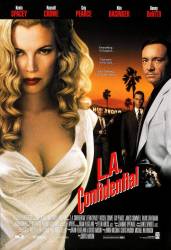Corrected entry: At the beginning when Bud is in the liquor store, and he first talks to Lynn, you see an overhead mic at the top of the screen. The next fee shots are from different angles or with the camera pulled away, but just before he leaves, they go back to the same scene between Bud and Lynn and the mic is there again as he says goodbye.
Corrected entry: When Bud visits Lynn (The scene where he punches her), as he walks up to her house, you can see a sunny area behind him, even though it is raining heavily.
Correction: Rain and sunshine may happen at the same time.
Corrected entry: License plate numbers are incorrect. In the 1950s, there were 5 digit plates, but in the film, there are 6 or 7, like nowadays. (00:37:40)
Correction: Six-digit license plates were used in California as early as 1917, and were used regularly throughout the 1930's and 1940's. The scheme shown on the cars in the 1952-based movie is consistent with the usage at the time. See http://www.davesclp.com/california.htm for examples.
Corrected entry: In the final shoot-out, Officer White advises Detective Exley that he is going under the building by pointing to a square open hole in the floor. The first shot of the hole shows it is clear with nothing blocking it; when White walks over to it there is now a board covering the hole that he has to kick through to break it.
Correction: The shot of the hole shows two openings with a board between them. The angle of the shot makes the hole in the foreground look larger than the hole in the back.
Corrected entry: When Kevin Spacey goes looking for the maroon Mercury Coupe, he drives up to the house where it is and the garage doors are closed. When he sneaks up one of the doors is open.
Correction: In the time it takes Exley and Vincennes to get out of their car, check out another car (which belongs to the other cops) and get to the back of the house, by circling it from the other side, the other detectives have just gotten there and are planting evidence. The door is now open signaling the dirty cops had just arrived.
Corrected entry: When Kevin Spacey is alone in the bar looking at the $50 bill (quite a close up), it's a bill dated from the 80's or 90's. (01:12:55)
Correction: This is incorrect. On the blu ray edition, you can see "series of 1934" printed in the upper left corner of the bill in the close up shot.
Corrected entry: When Bud White meets Buzz Meeks he rips his (Meeks') wallet from his hip pocket. Later, when he finds Meeks' dead body he retrieves the wallet from the inside pocket of Meeks' suitcoat. Plausible, but unlikely that Meeks changed his habit.
Corrected entry: The 1952-set movie is based around the premiere of the classic sci-fi movie, When Worlds Collide. Which is fine, except that the movie premiered in 1951.
Correction: The film it was based around the release of was released in 1951. It was premiered as Matt and the girl were arrested for possesion, and then later in the film Matt is out of prison, making it likely that the year would be 1952. thus making the date the film was set correct.
Corrected entry: When Bud is talking to Lynn about Susan Lefferts, Lynn says something to the effect that Susan "came on a bus with dreams of Hollywood, and this is how they turned out." But Bud later visits Susan Lefferts's mother, who lives in Elysian Park. That leaves three possibilities: One, Susan's mother originally lived somewhere other than Hollywood, and then moved there at some point. Two, Susan lived with someone other than her mother before coming to Hollywood. Three, the bus Lynn was referring to was a city bus - which would have travelled about six miles.
Correction: Lynn is using a cliché. "Arriving on the bus" is still used for hopeful actors arriving in Hollywood, and even for political hopefuls to some extent. The mayor even uses it, and Bud turns it around on him later.






Correction: Please rewatch the scene (time 00:09:05 and 00:09:23). It's not an "overhead mic at the top of the screen" in those two shots. What you see is the dark image of a pipe tobacco pack on the white background of a metal sign, attached to the liquor shelves. The sign reads "Cool Mild 10¢" with lower part of a pipe tobacco pack. The vintage sign is for "Granger Rough Cut Pipe Tobacco" from Liggett and Myers Tobacco. Here's an identical sign: https://www.worthpoint.com/worthopedia/vtg-granger-rough-cut-pipe-tobacco-440971789.
Super Grover ★